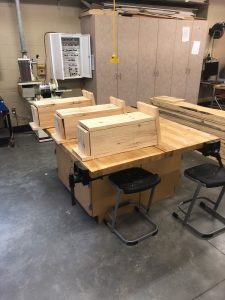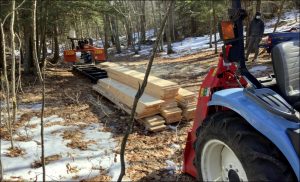The UConn Forest is 2,100 acres of living laboratory, full of research and teaching opportunities, under the management of the state Department of Natural Resources and the Environment. While walking through the forest a couple of years ago as part of his Dendrology lab course, UConn College of Agriculture, Health, and Natural Resources Associate Extension Professor and Forester Tom Worthley came across two substantial white pines that had been severely damaged. Though saddened that such massive sentinels of the forest had been destroyed, Worthley saw possibilities.
“Those broken trunks were either right alongside the trail, or less than a cable-length away. I thought what a challenge it might be to try to salvage some high-quality white pine boards from those standing trunks. Interesting thought, but I filed it away.”
However, Worthley was recently reminded of the idea when Waterford High School Technology and Engineering Education instructor Michael Bono contacted him, seeking lumber materials for his students. Bono is active with several conservation organizations, and he was looking specifically for materials to build wood duck boxes for wetlands and wood duck habitat areas.

“The ducks need a place to live and would usually find a hollow tree or something similar but trees that are big enough are kind of rare now,” says Worthley. “Groups will build boxes and place them up at the edges of the marshes. It has been a while since I heard about anyone working on wood duck boxes.”
Worthley didn’t have the materials on hand, so he proposed an idea to Bono.
“I asked if he would be willing to participate in a more comprehensive educational endeavor. I was thinking, of course, about the potential for salvaging those broken white pine trees,” says Worthley.
Bono thought it was a fantastic idea, so Worthley and the UConn Forest Crew got started earlier this year while the ground was still frozen and they could move equipment into the forest.
The project involved harvesting and processing the salvaged timber from UConn Forest by Worthley and the student-powered UConn Forest Crew, transporting the material to the high school where those students are manufacturing the wood duck boxes. The boxes will be given to conservation volunteers to install in wood duck habitat locations.
Andrew Muller ’22 (CAHNR), a member of the Forest crew says, “It’s been a lot of fun. We took out all of our equipment and we moved into the woods. We had to cut up the logs that had fallen and felled a couple others that were still standing, and then we’ve spent a couple of days just milling 12 foot by one foot boards for the students.”
“UConn Forest has a talented and energetic student crew, a small tractor, a portable sawmill and various other tools and equipment,” says Worthley.
As word about the project spreads, other projects are springing forth from the salvage efforts, including boxes for other birds like kestrels and mallard hens, as well as sign kiosks and trail markers for the UConn Forest.
Bono says his students were eager to get building and wasted no time in getting started: “My students unloaded the white pine and two students spent the last 20 mins of class building the fixtures to rough cut the pieces for assembly and quickly knocked out three boxes.”
Bono connected with Min Huang, UConn Natural Resources and Environment researcher and head of the Connecticut Migratory Bird Program, to help find the best locations where the boxes can be installed.

“To see something coming from Connecticut land, grown over the last 100 years or so to be made by Connecticut kids, and then put out to support Connecticut wildlife, how could that not be a great thing?” says Bono.
In reflecting on all the lessons stemming from a couple of broken trees, Worthley notes the importance of UConn Forest’s role as a working and teaching forest.
“It really was just a matter of taking these old trees and giving them a new life and new purpose, extending their life a little bit, tying up the carbon for a little bit,” he says. “Taking what might be a negative event and turning it into a positive outcome all while gaining skills and knowledge, there are lots of positive outcomes are associated with this project.”
The first batch of wood duck boxes has been delivered back to UConn, and Worthley will work with some of our wildlife specialists to identify locations for them.
Worthley will be engaging with the Waterford High School students in May to provide a remote lecture about the forest management and technical aspects of the white pine salvage operation and the students in turn will share their experiences with the manufacturing process.



